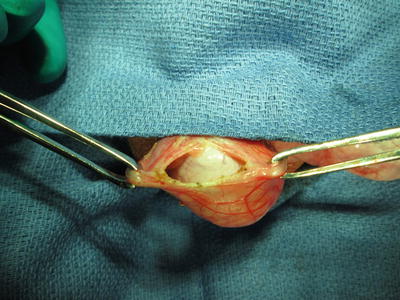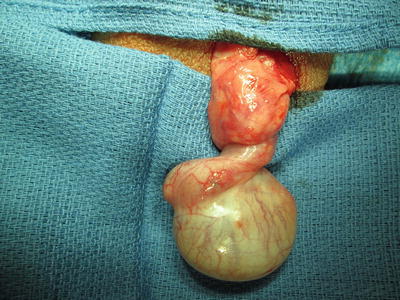Fig. 32.1
Median raphe incision

Fig. 32.2
Entry into the tunica vaginalis
The affected testicle is then brought out of the scrotum. Generally, there is a 360° twist in the spermatic cord (Fig. 32.3). The testis is then untwisted, which usually involves lateral turning of the testis. Notice the horizontal axis without a lower pole fixation, Bell clapper deformity, a transverse orientation of the testicle, which is seen in cases of testicular torsion (Fig. 32.4). Observe the testis during reperfusion. Intraoperative Doppler ultrasound can be used directly on the testis. If the testicle remains dark in color, and no blood flow is noted, then a small incision in the tunica albuginea may be made. If the testis does not bleed, then an orchiectomy must be performed. If an orchiectomy is to be performed, the spermatic cord should be divided in two sections, separating the vas from the vascular pedicle, and both should be suture ligated. If there is good flow documented with Doppler ultrasound after detorsion, and the color of the testicle returns to normal, then orchiectomy will likely not be required. The next step is to proceed with testicular fixation. A three-point fixation should be performed to prevent the recurrence of torsion. The fixation should be performed using a 3-0 absorbable or nonabsorbable suture. The suture should be placed through the tunica albuginea and dartos muscle, being careful to avoid piercing the skin.


Fig. 32.3




360° twist of the spermatic cord
Stay updated, free articles. Join our Telegram channel

Full access? Get Clinical Tree








